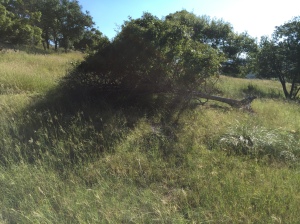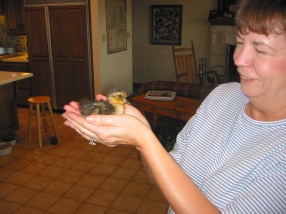As I trundle around my ranch, my gaze is often drawn to unusually shaped trees. For example, the tree below while fully developed, is missing its middle portion. It looks strange. The main branch likely broke off many years ago in a wind storm or lightning strike but has compensated by growing from its outer branches. Such adversity, such perseverance from this Live Oak tree. This tree has managed to overcome and become an attractive, if unusually appearing, tree once again.
The strong Texas winds during storms have blown down a number of other trees around the ranch. Most died soon after being toppled but surprisingly some have survived. The trees downed by wind had shallow roots with the root ball surfacing completely or partially. Several trees with some remaining root structure have survived. They eventually redirected some of their limbs skyward and, if not exactly thriving, at least continue to live.These trees are all Live Oaks, the name coming from always having leaves. As compared to the usual deciduous trees that lose their leaves in the winter, the Live Oak always appears to be alive and pushes off its old leaves in the Spring to make room for new ones. The strong life force of the Live Oak conjures up for me the verb “to live” as much as it does the adjective “live.”

Oddly shaped tree that likely lost its main trunk to wind or lightning many years ago

A toppled tree that has survived.

This felled tree not only has its trunk bent toward the sky but also has vertical shoots springing from near its base.
Looking at these challenged trees causes me to lean in and listen closely for their stories. It seems to me their botanical grit has frustrated the destructive forces of nature and offers a a metaphor for our human condition.
All of us are faced by life’s challenges. Fortunately most of our challenges are not serious but some are. A few of us have endured great challenges including death of a loved one, divorce, or loss of a job. Like the tree story, some people, despite such huge losses following their necessary grieving response, are able to re-establish their emotional grounding and get on with their lives. Others faced with similar or even lesser stresses sometimes just don’t bounce back as well. In my professional life as a neurologist, I was always surprised by how different people responded to bad news about their health. These responses varied widely. (if interested many examples are shared in my recently published book, Carrying The Black Bag: A Neurologist’s Bedside Tales) Which factors lead to these differences?
To continue the metaphor further, while external forces such as windstorms and lightning damage trees, an even greater menace to our oak studded ranch results from a tree disease known as Oak Wilt. This fungal disease spreads via a beetle through wounds to the tree or via its root system. It chokes off the channels that take up vital, life sustaining nutrition and hydration. In very short order, an affected tree loses its leaves and dies. A Red Oak tree will die within a day or two. Live Oaks take longer to die and despite being very ill, some will survive.

A tree killed by Oak wilt
The kill rate for oaks is 80-90%, yet some Live Oaks will maintain leaves on a limb or two and fight valiantly to survive.

An Oak tree severely affected by Oak wilt but will likely survive with a drastically altered shape
Without hopefully torturing the metaphor too greatly, It seems to me several points can be made. First, this serious tree fungal disease can be overcome by a few determined Live Oak trees. While damaged, the surviving trees, given enough time, will live and may even eventually become handsome trees once again. This is, i believe, an example of the strong life force of the Live Oak trees along with some good luck.
A second point relates to the higher death rate of those trees affected by the internal disease, Oak Wilt, as compared to the trees that sustain major damage by external forces. The internal forces of Oak wilt are more often fatal to the tree than are the external forces.
Might this also be true for people? We often face external adversity with greater determination especially if our own spirits are not sapped. Self-doubt, discouragement, depression, and hopelessness diminish the quality of our survival more so than do grievous external forces such as job loss, financial reversals, loss of a limb, or geographic relocations.
Oak trees are not humans. I get that. Yet, the apparent desire of Live Oak trees to persevere despite injury or illness provides a ready comparison for the human condition. Given that all of us will likely face a serious loss or illness, perhaps it is worth pausing to contemplate how we might nurture our fortitude and prepare ourselves for the inevitable.
Perhaps the tree story will help to nourish the hope that maintains our human existence during turbulent times.

























